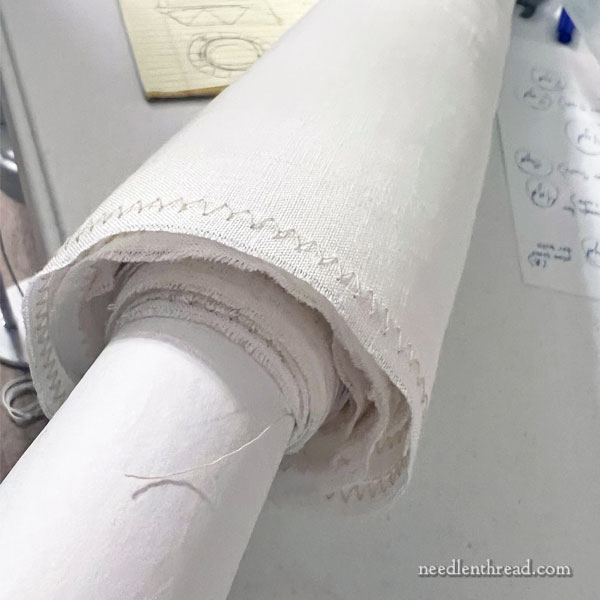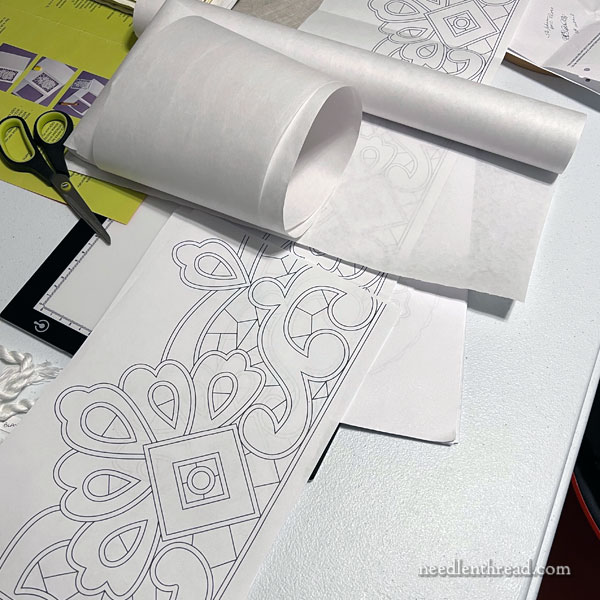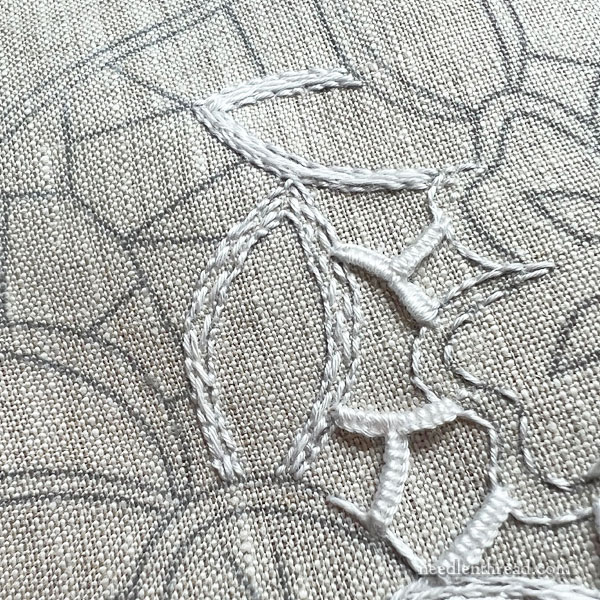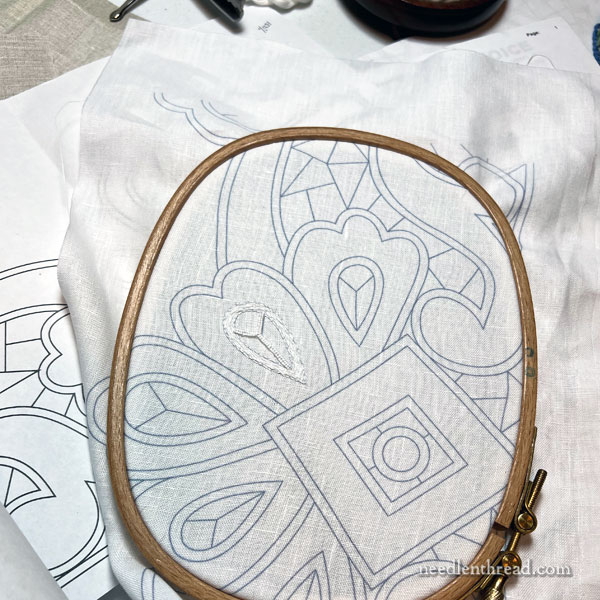Today, I’m going to chat with you about a Massive Embroidery Project that I’m not actually doing.
Well, I’m doing part of it. The least-fun part! I’m doing all the set-up and helping with some pointers to get it going.
I don’t consider it “my” project, since I’m not actually doing the embroidery. *Sigh*
It’s actually a good thing, because this project is Huge.

By huge, let me explain!
In the photo above, that’s a piece of linen approximately 17″ high and …. 21 feet long. Twenty. One. Feet. Long. That’s a long piece of linen.
The project is three altar cloths for a large church. (So, three pieces of linen, each 17″ x 21′.)
What is wanted for the cloths is a front decorative piece of cutwork in white linen that will extend the whole length of the altar plus its height on both sides. The linen is cut a little longer than necessary, to make sure there’s no shortage at the time of finishing.
The linen I’m using is the “Caster Sugar” linen in my white linen sample packs. It’s a beautiful linen, fine enough to be beautiful but crisp enough for cutwork. It is not quite medium weight. I think it’s lovely linen for decorative (or “fair”) altar linens.
To prepare the linen, I first cut it along the thread, in the width and length required. Then, I sewed around the edges with a simple zig-zag stitch on my sewing machine to neaten the edges a bit and reduce the fraying that can happen when a project is in the works for a long period of time. (You can read about neatening the edge of linen or fabric for embroidery projects here.)
Rinsing & Shrinking
To rinse the linen and shrink it completely, I used a big white plastic tub reserved for this purpose, and a hot-cold rinsing process.
I kept the linen folded up in a piece about 17″ wide and maybe two feet long. I didn’t wring or twist the linen at all during this hand-rinsing and shrinking process.
First, I soaked the linen in very hot water (too hot to hold your hand in it for long) until the whole linen was saturated with the hot water and warm all the way through. This requires a bit of lifting up and down and swashing in the water, but without messing up the linen.
I left it sitting in the hot water for a while. Then, I dumped off the hot water and rinsed the linen thoroughly in cold water (which, this time of year, is Very Cold), until there was no warmth in the linen at all. I made sure to open up the layers of linen and really get the cold water in there. You can put your hand between the various layers to feel if there is any warmth left in them – you really want the cold water to permeate everywhere. I let it soak a bit in the cold. At this point, the whole piece of linen goes very stiff!
Then, I dumped off all the cold and repeated this hot-cold process the same way, two more times. I left the linen in each hot rinse anywhere from 20 minutes to an hour, mostly until the water was tepid. Then, I dumped the water and ran very cold water over the linen again until it didn’t feel warm anywhere, filled the tub with cold water, submerged the linen in it, and let it soak.
After doing this three times, I boiled several kettles of water. I dumped the last cold rinse off and poured boiling water over the linen. I used some spatulas reserved just for this purpose to lift the linen layers and move the water through, and then to push the linen under the surface of the water and hold it there. I let it sit until it was room temperature (which takes a while!), then rinsed it in cold, and then laid the linen out in about a 17″ wide x 4-foot long folded stack, on a table covered with soft white towels.
I covered the linen with more soft white towels and pressed all over them with my hands, to help remove excess water from the linen. Then, I smoothed out the folded linen stack as neatly and wrinkle-free as possible, on a clean, hard table top, and let it dry to just-barely-damp.
Then, I ironed it all.
I did this with all three pieces of linen, all the same size.
The fabric is ready. The shrink is out of it. It feels marvelous and looks marvelous and is so smooth and pretty!

The design for the cutwork is from one of Joanna Jakuszewska’s Haft booklets. I wrote about Joanna’s cutwork kits recently, here. If cutwork is something you want to try, you should definitely check out her kits – they’re a great and affordable way to delve into the wonders of cutwork!
To apparently help fit the scale of the church, they wanted the design for the cutwork edge scaled up, enlarged about 150% from the original. Admittedly, I’ve got some reservations about this approach, but when you’re working for someone else, ultimately, it’s what they want that counts. So I expressed my reservations, and then went ahead to accomplish what they want.
My reservations are mostly dealing with upscaling a cutwork design. Your spaces of cutwork increase in size, but without more support. The bars get longer, and there’s a lot more open space between bigger areas of linen. So here and there, in the design, I added some more support bars where I thought they would be necessary, but where they would still flow with the design in a sensible way.
The other reservation is about the width of the embroidered edges of linen. The outlines of the embroidered elements are much wider, once a design like this is scaled up. I think the embroidery will definitely require more padding, to get good definition in the design. And this all affects, as well, the choices of thread weight and so forth.
So there’s a bit of work and fiddling to get the design to work at this scale.
There will be a total of at least 17 repetitions of the design, too, to create the whole cutwork edge. The transfer process requires some serious consideration. I’m still working on that! I’m testing different reasonable methods.

As far as the actual embroidery goes, regular cutwork thread works wonderfully on any of Joanna’s regular sized designs. This is a practice piece I set up, to demonstrate the methods and sequence of work. I’m using a design out of one of the Haft booklets. I transferred it onto natural colored linen so that it’s easier to see the techniques in progress.
I’m just using #25 cutwork thread (coton a broder #25).
I haven’t done any of the buttonhole stitching – just some outlining, padding, and the bars.

This is a test section of the enlarged design, set up on a scrap piece of the same white linen that will be used. I was testing sequences and techniques on the larger scale, using the same thread. I’m not sure about it. I think it will work, but I have a few more things I want to try.
Then, of course, there’s the whole washing process. If we transfer via an iron-on process, I want to make sure that the ink will not discolor the linen or the threads at all. With whitework, especially on this scale, it would be foolish to risk it without testing, testing, and more testing. With the time, materials, effort, and expense going into something like this, you can’t really risk an end product that doesn’t wash well!
So that’s a huge project going on in the studio at the moment. Once the testing is finished, the transfer is done, and the linen is set up on frames, I’ll hand these off to a few other people for the actual embroidery. And then I probably won’t see it again for at least a year.
I’ll let you know about any discoveries I make and things I learn as I finish up my part of this project!
I like this type of work, but it makes me a little nervous when it is at this scale, and for someone else. It’s one thing if I screw up my own stuff. It’s a completely different story when I mess up on someone else’s!
Heh heh.
Coming Up
On Friday, we will delve again into the Bee-Jeweled Pincushion project that started here with the design. I’ll clarify a few things about what you can expect. Don’t worry! I will give you all the information you need as the project progresses, just as I do with any tutorial series here on the website!
The kits sold out pretty fast (in under 4 minutes), but I am scurrying to prepare more – just waiting for more supplies to arrive! If you want to be on the advanced notice list for the kits so that you receive an email when they’re available again, just drop me a line!